Arica’s history stretches back over 10,000 years, shaped by ancient civilizations like the Chinchorro and the Inca Empire. This vibrant legacy is further enriched by Spanish colonial influences, creating a unique blend of indigenous traditions and colonial architecture. Visitors can enjoy this rich tapestry through exploring historical landmarks, artisanal marketplaces, and cultural events that celebrate the city’s enduring spirit. From the mesmerizing Ferrocarril Arica – La Paz to the captivating Vicuña Mackenna Square, Arica offers a glimpse into its millennia-old past that is sure to captivate the curious traveler.
Good To Know
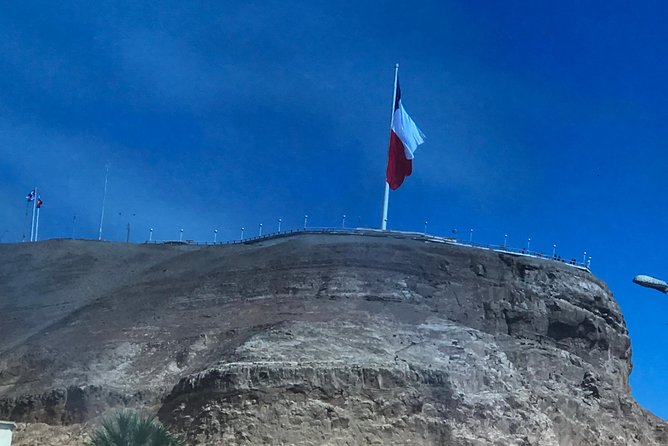
- Arica’s rich cultural heritage spans over 10,000 years, from the ancient Chinchorro culture to the Inca Empire and Spanish colonial influences.
- Arica’s cultural landscape features a blend of indigenous traditions and colonial architecture, offering visitors a glimpse into its diverse history.
- The Ferrocarril Arica – La Paz, a historic railway built in the late 19th century, served as a vital link between the Pacific coast and Bolivian highlands.
- The Maritime Governorate, built in 1926, exemplifies Arica’s maritime legacy and its role in regional trade and commercial development.
- Arica’s Vicuña Mackenna Square hosts the annual national cueca championship, celebrating the enduring cultural traditions of the region.
Millenary Culture of Arica
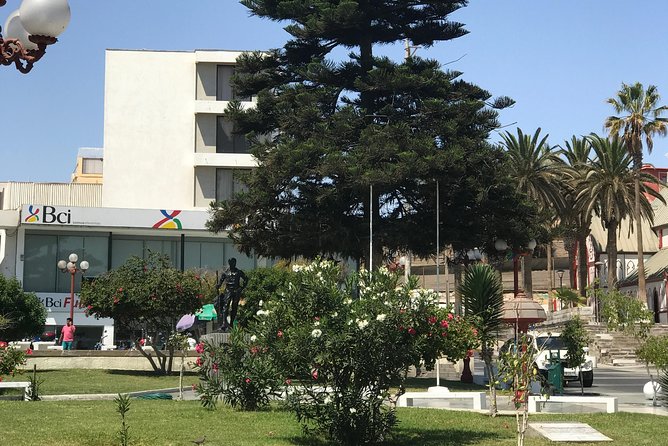
The rich cultural heritage of Arica is deeply rooted in its millenary past, having witnessed the rise and fall of numerous civilizations over the course of 10,000 years.
From the ancient Chinchorro culture to the Inca Empire and the Spanish colonization, each era has left an indelible mark on the city.
Today, Arica’s cultural landscape is a tapestry of indigenous traditions, colonial architecture, and modern influences, all seamlessly woven together.
Visitors can enjoy this vibrant heritage by exploring the city’s historical landmarks, museums, and artisanal marketplaces, gaining a profound understanding of the resilience and adaptability of the Arica people.
You can also read our reviews of more tours and experiences in Arica.
Highlights of the Arica Tour
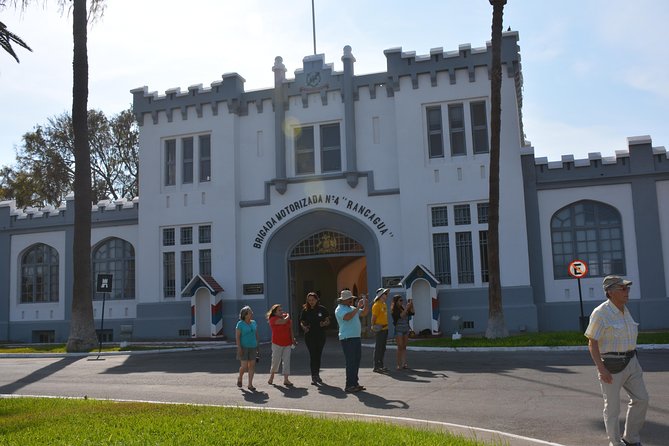
Arica’s rich cultural heritage comes alive on the city’s historical tour, where visitors can enjoy the captivating stories of the past.
The tour’s itinerary highlights key sites like the City Center, Eiffel Square, and the Maritime Governorate, offering a glimpse into Arica’s evolving landscape.
Travelers can explore the Ferrocarril Arica – La Paz and the fishing port terminal, as well as the Vicuña Mackenna Square, the site of the national cueca championship.
The tour also takes visitors to the East Fort, the Morro de Arica summit, and the Agro Terminal, showcasing the diverse facets of Arica’s history.
With excellent guides, personalized attention, and an accessible experience, the Arica historical tour is a must-do for those seeking to uncover the city’s rich cultural tapestry.
Exploring the City Center
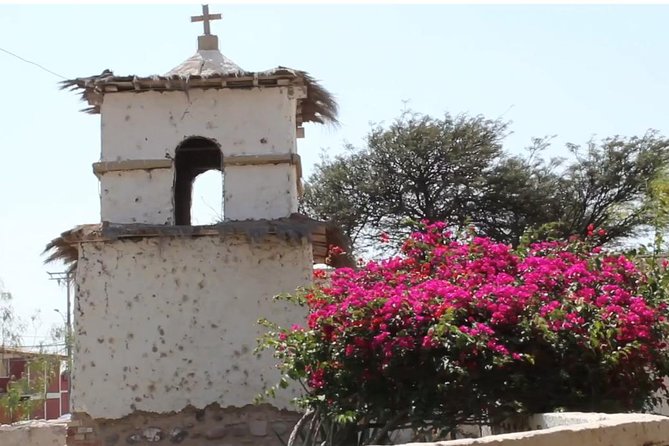
One’s journey through Arica’s storied City Center reveals the heartbeat of the city’s rich heritage.
The bustling square of Eiffel hosts eye-catching colonial architecture dating back to 1874. Nearby, the Ferrocarril Arica – La Paz terminal evokes the region’s crucial role in rail transport.
The Maritime Governorate, built in 1926, stands as a testament to Arica’s maritime legacy.
Vicuña Mackenna Square, the site of the national cueca championship, showcases the vibrant cultural traditions that have endured.
From the historic Scorpion Island to the rejuvenating Laucho and La Lisera Spa, every corner of the City Center invites travelers to enjoy Arica’s captivating past.
Ferrocarril Arica – La Paz
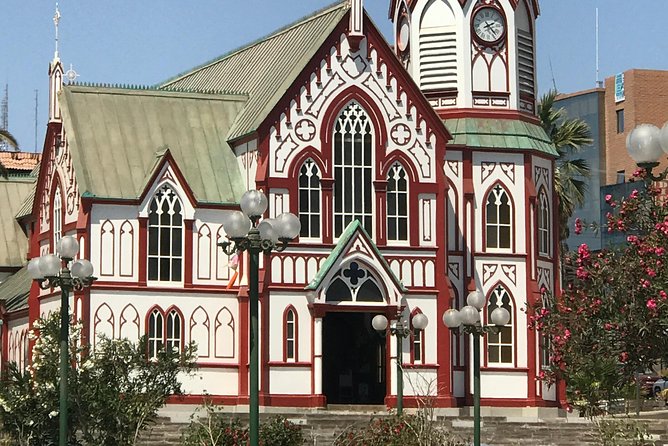
Connecting the City Center to the past, the Ferrocarril Arica – La Paz terminal stands as a testament to the region’s pivotal role in rail transport.
This historic structure, built in the late 19th century, served as a vital link between the Pacific coast and the Bolivian highlands. The terminal’s strategic location made it a hub for the movement of goods and people, facilitating trade and cultural exchange.
Today, visitors can explore:
- The terminal’s striking architectural features, blending European and local design elements.
- Exhibits showcasing the terminal’s role in the economic and social development of the region.
- The nearby fishing port, where the bustling activity echoes the terminal’s former commercial importance.
Maritime Governorate and Landmarks
The Maritime Governorate, a striking architectural landmark, stands as a testament to Arica’s maritime heritage. Constructed in 1926, the building’s neoclassical design reflects the city’s role as a crucial port along the Pacific coast.
Today, it houses the regional government offices, overseeing the area’s maritime activities. Nearby, the Ferrocarril Arica – La Paz terminal and fishing port terminal showcase Arica’s continued importance as a transportation hub and fishing center.
Visitors can explore the city’s rich maritime legacy, from the historic Morro de Arica summit to the bustling Agro Terminal, offering a glimpse into the vibrant commercial life that has defined Arica for generations.
Vicuña Mackenna Square and Cueca
Situated at the heart of Arica, Vicuña Mackenna Square serves as a vibrant hub for the city’s cultural heritage.
It’s the site of the annual national cueca championship, a traditional Chilean folk dance that has deep roots in the region.
The square features:
- A lively performance stage where dancers showcase their intricate footwork and graceful movements.
- Vendors selling traditional crafts, clothing, and local delicacies, offering a glimpse into Arica’s artisanal culture.
- Families and locals gathering to socialize, enjoy the festive atmosphere, and preserve the cherished cueca tradition.
This iconic plaza represents the enduring spirit and pride of Arica’s people, making it a must-visit destination for any traveler exploring the city’s rich history and cultural tapestry.
Outdoor Recreation and Spa
Beyond the cultural landmarks that define Arica’s heritage lies a captivating world of outdoor recreation and rejuvenating spa experiences.
The Laucho and La Lisera Spa offer a chance to unwind and indulge in therapeutic treatments, drawing upon the region’s natural mineral-rich waters.
Visitors can also explore the former Scorpion Island, now a haven for birdwatching and coastal hikes.
The tour includes a visit to the Agro Terminal, showcasing the agricultural abundance of the area.
Whether seeking relaxation or adventure, Arica’s outdoor attractions and spa facilities provide a well-rounded experience for travelers seeking to enjoy the city’s multifaceted allure.
Accessibility and Convenience
Designed to accommodate visitors of all abilities, the Arica historical tour ensures accessibility and convenience throughout the experience.
Travelers can take advantage of the following features:
- Wheelchair and stroller accessibility, making the tour inclusive for individuals with mobility needs.
- Infant-friendly arrangements, catering to families with young children.
- Pickup options from various locations, including hotels, airports, and ports, providing flexibility for participants.
The tour’s focus on accessibility and convenience reflects its commitment to providing a seamless and inclusive experience for all who wish to explore the rich history and cultural heritage of Arica.
Frequently Asked Questions
What Is the Best Time of Year to Visit Arica?
The best time to visit Arica is year-round, as the city’s mild climate ensures comfortable conditions for exploring its historical sites and cultural attractions. However, the summer months of December to March are particularly popular with travelers.
Are There Any Unique Local Cuisine or Dishes to Try?
Arica’s unique local cuisine features fresh seafood, Peruvian and Bolivian influences. Travelers shouldn’t miss tasting ceviche, empanadas, and the traditional chicha morada drink made from purple corn.
What Are the Popular Souvenir Items From Arica?
Popular souvenir items from Arica include local handicrafts like woven textiles, ceramics, and leather goods. Visitors can also find traditional musical instruments, Andean artwork, and regional products like dried fruits and spices.
Are There Any Special Events or Festivals That Take Place in Arica?
Arica is home to several vibrant festivals and events. The annual National Cueca Championship takes place in Vicuña Mackenna Square, celebrating the national dance of Chile. Other popular events include the Arica Carnival and various cultural festivals showcasing the city’s rich heritage.
Are There Any Safety Considerations for Tourists in Arica?
Arica is generally safe for travelers, but visitors should exercise caution. Petty theft and pickpocketing can occur, so it’s wise to keep valuables secure. Tourists should also be aware of their surroundings and avoid isolated or poorly lit areas at night.
The Sum Up
Arica’s rich history, spanning over 10,000 years, offers a captivating tapestry of ancient cultures, colonial influences, and vibrant community spirit. Visitors can enjoy this legacy through exploring historical landmarks, artisanal markets, and cultural events, while also enjoying the city’s outdoor recreation and accessibility. Arica’s enduring charm invites travelers to uncover its enduring legacy and embrace the unique blend of the region’s past and present.
